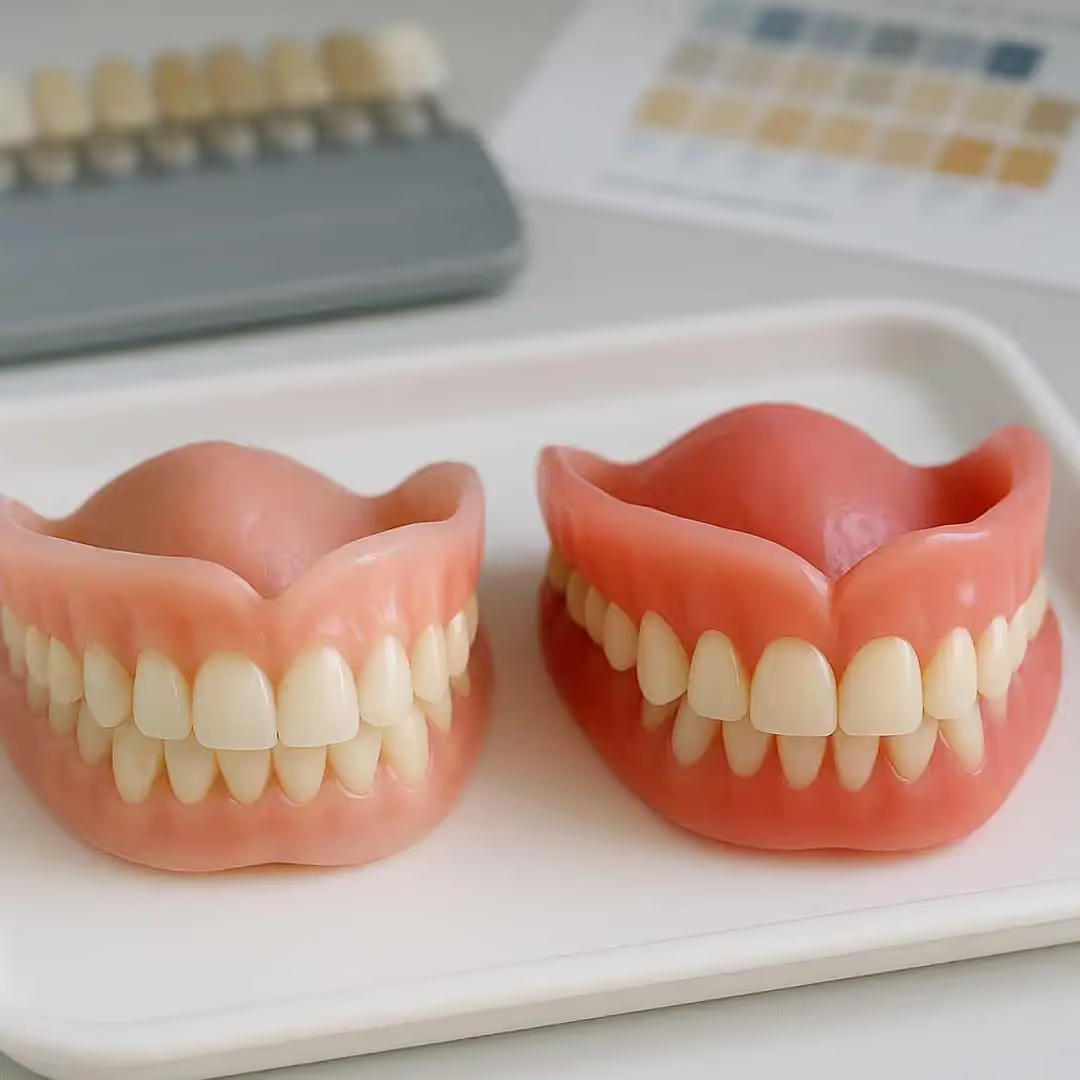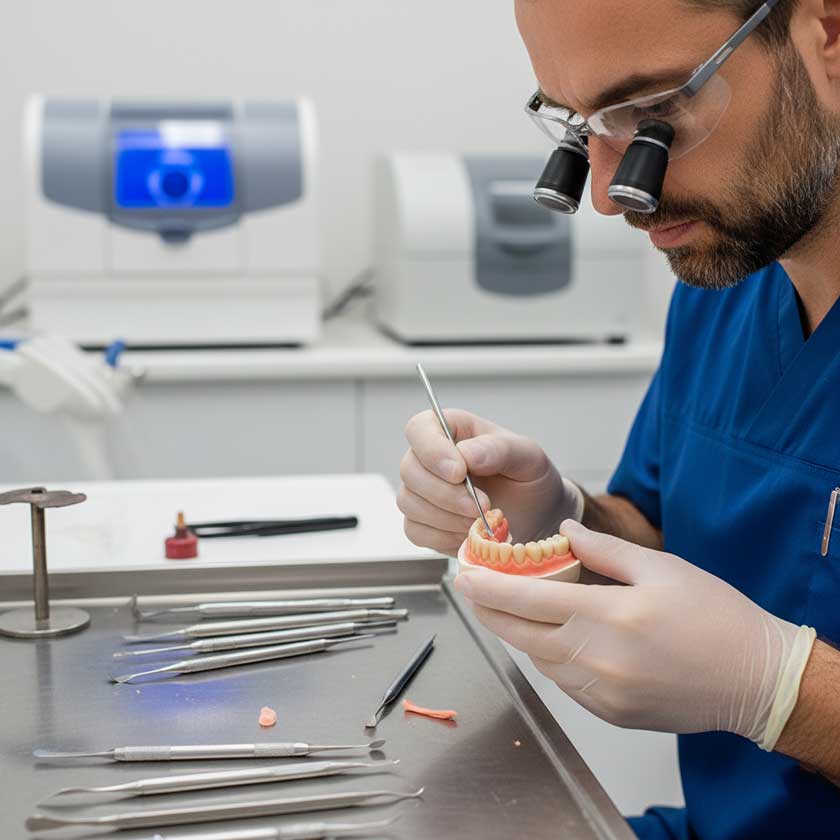The aesthetics of dentures significantly influence patient satisfaction and overall quality of life. An increasing number of people are choosing dentures due to their custom-crafted nature and advancements in technology that enhance their natural appearance and comfort. Additionally, dentures offer several advantages compared to other types of dental care, making them a preferable and effective option over implants for many individuals. Accurately matching dentures to the natural shade of teeth and gums is essential for achieving a harmonious, natural appearance (dentallab-direct.com). Beyond mere aesthetics, properly matched denture shades have important psychological and social impacts. Dentures that blend seamlessly with natural oral tissues help boost self-confidence, enhance social interactions, and promote psychological well-being.
However, achieving a precise shade match can be challenging. Factors like lighting conditions, timing of shade selection, and eye fatigue can significantly affect the accuracy of shade matching (treasuredental.com). Additionally, research has shown that noticeable color mismatches between artificial and natural teeth are common, underscoring the complexity of the shade matching process (pubmed.ncbi.nlm.nih.gov). Dentists and dental technicians must navigate these challenges carefully by utilizing shade guides designed specifically for denture fabrication, considering mucosal and tooth coloration, and being mindful of the numerous factors affecting color perception (pmc.ncbi.nlm.nih.gov).
Key Takeaways

Understanding shade matching basics.
Defining shade matching
Shade matching in dentistry refers to the process of selecting the appropriate color for artificial dental restorations, such as dentures, to closely resemble the natural appearance of a patient’s teeth and gums. Dentists utilize a shade guide to accurately match the color of artificial teeth and gums with those of a patient's natural teeth and gums. It is important to select different shades during the tooth and gum shade matching process to find the one that best resembles the patient's natural teeth or gums, ensuring a more aesthetically pleasing fit for dentures. Accurate shade matching aims to achieve a seamless, harmonious integration of dentures with the patient’s oral tissues, making the artificial teeth appear indistinguishable from natural teeth. Proper shade matching contributes significantly to the aesthetic success and patient satisfaction of dental restorations (dentallab-direct.com). Tooth shades vary based on age, complexion, and personal preferences, which makes individualized shade selection a critical aspect of the process.
Components of shade matching
Shade matching generally includes two main components:
- Teeth Shade Matching: This involves selecting the color of artificial teeth that accurately reflects the patient’s natural tooth color. Teeth shade matching considers factors like hue, chroma, and value, ensuring the artificial teeth blend naturally with existing teeth (treasuredental.com).
- Gum (Mucosal) Shade Matching: This involves selecting the shade of the denture base material to match the color of the patient’s gums or mucosal tissues. Natural gums exhibit subtle color variations, and proper gum shade matching helps dentures appear natural and enhances their overall aesthetic appearance (pmc.ncbi.nlm.nih.gov).
Both components—teeth and gum shade matching—are equally significant for achieving a natural, aesthetically pleasing appearance. When both elements are accurately matched to the patient’s natural oral tissues, the dentures blend seamlessly, resulting in a cohesive and realistic smile (dentallab-direct.com). The dental lab plays a crucial role in customizing and fabricating dentures to match selected shades, utilizing advanced technologies like CAD/CAM and 3D printing for precision.
Factors influencing shade matching accuracy.
Environmental factors
Proper lighting conditions play a crucial role in accurately matching the shade of dentures to natural teeth and gums. Lighting directly influences how colors are perceived, making it essential to evaluate shade under appropriate conditions. Natural daylight is generally preferred over artificial lighting, as it provides the most accurate representation of true colors. Artificial lighting, depending on type and intensity, can distort color perception and lead to incorrect shade matching. For best results, shade evaluation should ideally take place under standardized natural lighting conditions, typically near a window at midday, to minimize inaccuracies (treasuredental.com).
Human factors
Human factors significantly impact the accuracy of shade matching. Timing of the shade assessment is critical; ideally, shade comparisons should be done at the beginning of an appointment to avoid the effects of eye fatigue. Extended periods of visual assessment can diminish the clinician's ability to discern subtle shade differences, leading to potential mismatches (treasuredental.com). Additionally, personal biases and perceptual differences among clinicians can also affect the outcome. Clinicians should be aware of their own perceptual tendencies and take deliberate steps to mitigate bias, such as involving a second opinion when in doubt.
Material considerations
Material differences between artificial teeth and natural dentition can complicate the shade matching process. Using high-quality materials in the production of dentures is crucial to enhance comfort, durability, and natural appearance. A high-quality denture should also resemble real gum tissue, using a mix of pink and translucent shades to create a natural appearance that blends seamlessly with existing gums. Artificial teeth are manufactured using specific acrylic resins and pigments, and while these materials are engineered to mimic natural teeth, subtle differences often remain (pubmed.ncbi.nlm.nih.gov). Variations in available acrylic shades also present challenges, as certain hues or translucencies may not precisely align with natural teeth or gum tissue. Clinicians and technicians must carefully evaluate available materials and choose the closest possible match, considering the inherent limitations of acrylic resins to replicate natural dental tissues accurately.

Tools and techniques for shade matching
Shade guides
Shade guides are essential tools for accurately matching the color of dentures to natural teeth and gums. These guides feature various shades to aid dental professionals in selecting the appropriate color. The first step in the shade matching process is scheduling a consultation, which is crucial for achieving a beautiful smile with custom dentures. These guides consist of color tabs arranged systematically according to hues, chroma, and value, allowing dental professionals to visually compare and select the closest match to the patient’s natural dentition (pmc.ncbi.nlm.nih.gov). The guides are typically used under controlled lighting conditions to ensure accuracy and reproducibility.
There are two primary types of shade guides available: standard shade guides and customized shade guides. Standard shade guides are pre-manufactured and widely used due to their ease of use and convenience. However, because each patient has unique coloration, customized shade guides offer greater precision by being specifically tailored to an individual’s teeth and gum characteristics.
Additionally, mucosal-specific shade guides have recently emerged, designed explicitly to match the patient’s gum (mucosal) color more effectively. These guides are particularly helpful in selecting the shade for denture bases, contributing to a more natural and harmonious appearance of dentures (pmc.ncbi.nlm.nih.gov).
Advanced technology in shade matching
In recent years, digital technologies have significantly advanced the accuracy and consistency of shade matching. Digital shade matching technologies utilize specialized devices and software to quantify and analyze color objectively, further reducing the likelihood of human error.
Among these technologies are spectrophotometers and colorimeters. Spectrophotometers measure the spectrum of reflected light from the tooth surface, providing precise color data. Colorimeters, on the other hand, measure the intensity of red, green, and blue wavelengths reflected by the teeth and gums, presenting simplified but useful color matching results.
The primary benefits of technology-assisted shade selection include improved precision, reduced subjectivity, and consistent reproducibility. However, limitations also exist, such as high initial investment costs, the requirement for specialized training, and occasional discrepancies caused by environmental conditions or equipment calibration. Nonetheless, these advanced tools represent a significant step forward in achieving optimal aesthetic outcomes for denture wearers.
The shade matching process step-by-step
Initial patient assessment
The first crucial step in matching denture shades to natural teeth and gums is the initial patient assessment, where the dentist evaluates the patient's natural teeth. This first step is essential as it sets the foundation for the entire denture process. A thorough consultation allows the dentist to understand the patient’s expectations and preferences, as well as evaluate their oral condition. During the consultation, the dentist records baseline shades of the patient’s existing teeth and gum tissues. This initial documentation provides a reference point and is essential for achieving a harmonious and natural appearance in the final denture (dentallab-direct.com).
Shade selection procedure
Careful shade selection is critical and should ideally occur at the beginning of the appointment, as the teeth may change slightly in shade throughout the appointment due to dehydration. Maintaining custom dentures is essential to ensure their longevity and functionality. The dental lab plays a crucial role in the shade selection procedure, utilizing advanced technologies like CAD/CAM and 3D printing for precision.
Optimal conditions for shade selection include natural daylight or standardized shade-matching lights, as ambient lighting can significantly impact color perception (treasuredental.com). Dentists commonly use shade guides, which contain samples of tooth and gum colors, to help identify the most accurate shade match. Effective communication among the dentist, laboratory technician, and patient ensures consistency and accuracy throughout the process (pmc.ncbi.nlm.nih.gov). Clear instructions and mutual understanding help minimize discrepancies and ensure patient satisfaction.
Denture fabrication and verification
Once the appropriate shades have been selected, the denture process begins as a collaborative journey between the dentist and patient, where they finalize the denture's appearance over several weeks and multiple appointments. The use of high-quality materials in the fabrication of dentures is crucial to enhance comfort, durability, and natural appearance.
The dental laboratory technician translates these selections into the fabrication of the dentures. Accurate reproduction of selected shades in denture acrylic and artificial teeth is key to achieving a natural look. Verification typically involves a trial fitting session where the patient can evaluate the aesthetics. Adjustments can be made during this stage to correct any discrepancies in shade or appearance, ensuring the final product aligns with patient expectations and provides a natural, harmonious smile (pmc.ncbi.nlm.nih.gov). Dentists can also create wax forms and plastic patterns during this stage to finalize the denture's shape and color, allowing for further refinements before the final product is fabricated.
Special considerations for gum (mucosal) shade matching
Accurately matching the shade of the denture base to the mucosal color is crucial for achieving a natural and aesthetically pleasing appearance that blends seamlessly with natural gums. A high-quality denture should resemble real gum tissue, using a mix of shades that mimic the subtle variations found in real gum tissue, ensuring that dentures look authentic and blend seamlessly with existing gums.
A denture base closely matched to the patient’s mucosal tissues enhances the overall harmony of the facial expression and reduces the perception that dentures are present (pmc.ncbi.nlm.nih.gov).
To achieve accurate mucosal shade matching, dental professionals utilize various techniques. One common approach involves using specialized shade guides specifically developed for mucosal color selection. Such guides help clinicians in selecting the appropriate denture base shade by closely comparing available shades with the patient’s gums under standardized lighting conditions.
Another critical aspect is the use of custom staining and tinting. This process involves applying specific pigments or stains to the denture base material, allowing precise adjustments to better mimic the individual’s natural gum shades and subtle variations. This customization can significantly improve the visual authenticity of dentures, providing a seamless integration with the patient’s existing oral tissues.
Customization options for dentures.
Dentures can be customized to fit a patient’s specific needs and preferences. This includes choosing the right shade and color of the artificial teeth to match the patient’s natural teeth, as well as selecting the right gum shade to blend seamlessly with the patient’s existing gums. Patients can also choose from various materials and components, such as precision attachments, to create a more natural-looking denture. Additionally, dentures can be designed to match the patient’s natural teeth and gums, providing a more realistic appearance.
Flexible denture options
Flexible dentures are a type of denture that is made from a flexible material, such as nylon or acrylic. They are designed to be more comfortable and durable than traditional dentures, and can be used to replace one or multiple teeth. Flexible dentures are also less likely to break or crack, making them a popular option for patients who want a more natural-looking and comfortable denture. They can be customized to fit a patient’s specific needs and preferences, and can be used in conjunction with other dental appliances, such as dental implants.
Fitting and adjustments for comfort
The fitting and adjustment process for dentures is an essential step in ensuring a comfortable and natural-looking fit. During the initial consultation, the dentist will assess the patient’s oral health and take impressions of their teeth and gums. The dentist will then use these impressions to create a custom-made denture that matches the patient’s natural teeth and gums. The patient will then try on the denture and the dentist will make any necessary adjustments to ensure a comfortable and proper fit. This may include adjusting the bite, shape, and size of the denture, as well as making any necessary adjustments to the gum shade and tooth color.

Common mistakes and solutions in shade matching.
Frequent errors and their causes
Shade mismatches between dentures and natural teeth or gums are common but avoidable errors. The shape of the mouth can significantly affect denture comfort and fit, making it crucial to customize dental devices to the individual's mouth. Additionally, subtle color variations in the gum bases are essential for achieving a natural appearance. A frequent mistake is selecting shades under inappropriate lighting conditions, such as overly bright artificial lighting or dim environments, which can distort color perception (treasuredental.com). Additionally, shade selection done when the clinician experiences eye fatigue or visual strain often results in inaccurate color choices, leading to noticeable mismatches (treasuredental.com). Another common error involves overlooking the natural mucosal color of the patient’s gums, resulting in dentures that appear artificial or mismatched (pmc.ncbi.nlm.nih.gov).
Strategies to avoid color mismatches
To prevent shade matching errors, it is essential to select shades under standardized, natural daylight conditions, ideally midday sunlight, as this provides the most accurate color representation (pmc.ncbi.nlm.nih.gov). Clinicians should use reliable shade guides specifically designed for denture fabrication, carefully comparing them with the patient’s existing natural teeth and gums (pmc.ncbi.nlm.nih.gov). It is also beneficial to perform the shade selection early in the appointment to avoid eye fatigue and visual misjudgment (treasuredental.com).
Correcting shade mismatches post-fabrication
Despite careful planning, shade discrepancies can occasionally occur after denture fabrication. In such cases, minor shade corrections may be possible through selective staining or tinting techniques applied to the artificial teeth or denture base material to better harmonize with the patient's natural oral tissues (dentallab-direct.com). For more significant mismatches, refabrication or replacement of the denture teeth may be necessary. Communication with dental technicians is essential to identify the exact areas of mismatch and determine the best corrective approach (pubmed.ncbi.nlm.nih.gov).
Enhancing the natural appearance of dentures.
Creating natural looking dentures that closely replicate the natural appearance of teeth and gums requires careful attention to several specific techniques. Incorporating slight variations in tooth size is also crucial, as these imperfections contribute to the overall realism and uniqueness of a smile, making it more characterful and less uniform. Realism and harmony in denture aesthetics depend significantly on factors such as texture, translucency, and proper contouring.
To achieve a realistic and harmonious look, proper shade matching is essential. Dentists and dental technicians utilize specialized shade guides designed to match the denture base closely to the color and tone of the patient’s gums and mucosal tissues. This careful selection helps dentures blend seamlessly, enhancing their natural appearance (pmc.ncbi.nlm.nih.gov).
Texture plays a crucial role as well. Natural teeth and gums have subtle surface variations and textures. Mimicking these textures in dentures helps prevent an overly smooth or artificial appearance, adding depth and realism to the overall look. Additionally, incorporating translucency in artificial teeth can replicate the natural enamel’s optical characteristics, contributing significantly to an authentic appearance (dentallab-direct.com).
The contouring of dentures, including the shape, size, and alignment of artificial teeth, is another factor that greatly affects their natural look. Teeth should be contoured and positioned in a way that mirrors the patient’s original dentition, achieving balance and harmony in the smile.
To maintain consistency in appearance over time, regular cleanings, proper denture hygiene, and periodic professional check-ups are recommended. Denture materials can discolor or deteriorate gradually, altering their initial appearance. Consistent care routines and periodic adjustments ensure dentures retain their intended color, texture, and contour, preserving the natural and harmonious look in the long term (treasuredental.com).
Conclusion
Matching the shade of dentures to natural teeth and gums is critical for achieving a seamless and natural appearance. Key factors in successful shade matching include selecting appropriate shade guides that closely match the patient's teeth and mucosal color, considering lighting conditions during shade selection, and accounting for factors such as timing and eye fatigue (treasuredental.com). Additionally, understanding the inherent color differences between artificial and natural teeth can significantly reduce the risk of mismatch and dissatisfaction (pubmed.ncbi.nlm.nih.gov).
Effective shade matching requires close collaboration among dental professionals, including dentists, dental technicians, and patients themselves. Open communication ensures that patient expectations and preferences are clearly understood, resulting in improved patient satisfaction and a more aesthetically pleasing outcome.
Looking forward, advances in shade matching technologies and methods promise more precise and predictable results. Innovations such as digital shade matching, advanced shade guides customized for mucosal coloration (pmc.ncbi.nlm.nih.gov), and improved dental materials are expected to further enhance the accuracy and aesthetics of dentures. Staying informed about emerging trends and research in denture shade matching will enable dental professionals to deliver optimal care and achieve even more natural-looking restorations in the future.







